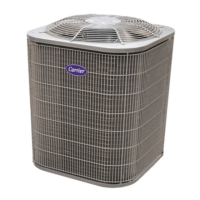
Do you have a question about the Carrier GH7T and is the answer not in the manual?
Warning about personal injury or death from electrical shock during installation or servicing.
Warning about potential explosion or injury due to improper handling of air or oxygen with refrigerant.
Guidance on routing refrigerant tubes to minimize noise, avoid contact, and properly seal wall penetrations.
Caution regarding sharp edges on sheet metal parts during handling.
Instructions for unpacking, inspecting, and verifying unit rating plate information.
Requirements for securing the unit to a level pad, including tie-down methods.
Specifications for maintaining adequate space around the unit for airflow, wiring, and service.
Caution to ensure unit stability in all circumstances, including adverse weather.
Caution to elevate the unit for drainage and to prevent water/ice buildup in the base pan.
Table detailing required accessories for low ambient, long line, and sea coast applications.
Instructions for installing the LSV kit in long-line applications for proper operation.
Safety warnings and procedures for making refrigerant piping connections.
Safety warnings and procedures for brazing refrigerant lines and components.
Instructions for installing the required filter drier, including heat sinking during brazing.
Procedure for evacuating the system to 500 microns using the deep vacuum method.
Instructions for routing and connecting ground and power wires to the unit control box.
Safety warning and diagram for connecting system ground and power wiring.
Guidelines for connecting 24v control wires to the thermostat and unit.
Wiring diagrams for connecting thermostats to fan coil and variable speed furnace units.
Important checks to ensure secure wiring and proper routing before closing panels.
Requirements for powering the crankcase heater before unit startup.
Instructions for selecting proper airflows for high and low stage cooling on ECM furnaces.
Instructions for setting DIP switches to match airflow for variable speed furnaces.
Step-by-step instructions for starting up the system after installation.
Explanation of how the unit operates in cooling and heating modes.
Details on the 2-stage compressor's internal unloading mechanism and capacity modulation.
Explanation of the Quiet Shift-2 mode for reducing noise during defrost cycles.
Description of the defrost control board's time/temperature settings and operation.
Procedure for initiating a forced defrost cycle using speedup pins.
Procedure for checking and adjusting refrigerant charge based on subcooling method.
Guidance on using the heating check chart to verify system operation.
Checks for proper suction pressure and current changes during stage switching.
Methods to verify the operation of the compressor's unloader mechanism.
Final important checks before leaving the job site, including wiring, security, and documentation.
Table and notes for troubleshooting compressor winding resistance.
